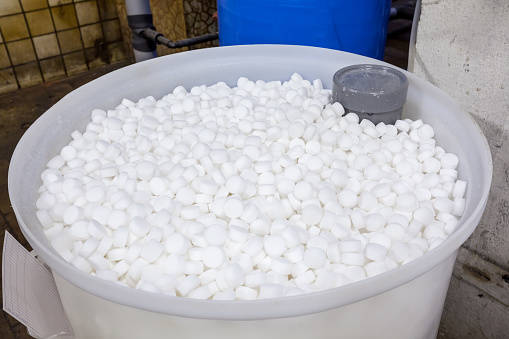Southern Nevada’s hard water may call for softener installation

Q: We are from California and just moved into a new house. The problem is that the water in Southern Nevada is different. My skin is dry and itchy right after a shower. I understand that a water softener is in order, so I bought one that uses salt at a home center and am ready to install it. Fortunately, we have a loop in the garage, and I have sweated copper a few times before. Is there anything to look out for?
A: Welcome to the desert. Our water is harder than a tax collector’s heart, and people either buy a softener or use a lot of lotion.
A softener is a good investment, since it prolongs the life of your plumbing fixtures and is a nice feature when you sell your house. The price of water softeners ranges from about $450 into the thousands of dollars, depending on various features.
The basic idea behind a softener is simple. Inside the tank are thousands of tiny plastic resin beads. As hard water passes through the tank, the beads attract the minerals that make the water hard. What is left is soft water that flows to your plumbing fixtures. After a while, the resin beads can’t hold any more minerals and require a good cleaning.
This cleaning occurs as the softener recharges (some softeners recharge at a predetermined time, while others recharge only when the computer senses the need to recharge). Salt water is flushed through the resin tank to clean the beads so that they can attract more minerals from the incoming water. There are softening systems that do not use salt, but your low-end softener will use salt pellets.
Since you already know how to sweat copper, this installation will be a breeze for you. For others not so experienced with a torch, check out my column on sweating copper.
The first thing to do is turn off the water to the house and open a faucet to relieve pressure. Next, cut the copper loop in your garage so that you have two copper stubs coming from the wall. You will sweat a male adapter onto the end of each pipe and use copper flex pipes to connect the stubs to the softener.
Most softeners at home centers and department stores will have a bypass valve that plugs into the unit. Other softeners will require that you pipe one in. The bypass valve allows you to bypass the softener if necessary.
The biggest thing to watch for is connecting the water correctly. Make sure you know which stub the water flows out of (the incoming water) and which stub returns water to the house. If you need, you can turn the water on for a second to find out.
Remove the cover of the softener. Pipe this stub to the water valve inlet at the top rear of the softener.
The valve outlet is connected to the other stub which returns water to the house. Since you have already sweated male adapters onto the stubs, it is a simple matter of screwing the copper flex pipes onto them and then bending the flex pipes to meet the softener fittings.
Wrap each threaded fitting three times with Teflon tape and screw it all together. Bend the flex pipes gradually as you don’t want any kinks that might restrict water flow.
Depending on which way the water flows, you might just be able to line up the flex pipes and screw them right into the softener inlet and outlet. If your water flows in the opposite direction, you will need to cross over the flex pipes so that the water flows through the softener in the right direction. Lengths of 18 to 24 inches will give enough play to cross over the pipes.
With the plumbing connected, you need to hook up the drain line. It is simply a tube that connects the softener to the drain. When you have a loop installed in your house, you will also have a drain pipe next to it. It will look like a half-inch copper stub with a cap on it.
Cut the cap off and connect the hose to the drain stub with a hose clamp (some units come with a drain hose). The other end of the hose connects to the drain fitting at the top rear of the softener. You will also need to attach a hose to the tank overflow in case the water level rises too high.
Finally, connect the grounding clamp (supplied with your softener) to your cold water pipes.
Slowly turn the water back on (some manufacturers will give you a sequence to follow) and check for leaks. The manufacturer will give you instructions on starting up and programming the softener. Then just add salt and cut down on the lotion.
Mike Klimek is a licensed contractor and owner of Las Vegas Handyman. Questions may be sent by email to handymanoflasvegas@msn.com. Or mail to 4710 W. Dewey Drive, No. 100, Las Vegas, NV 89118. His web address is www.handymanoflasvegas.com.
Do-it-yourself
Project: Install a water softener
Cost: $450 or more
Time: 2-4 hours
Difficulty: ★★★★














